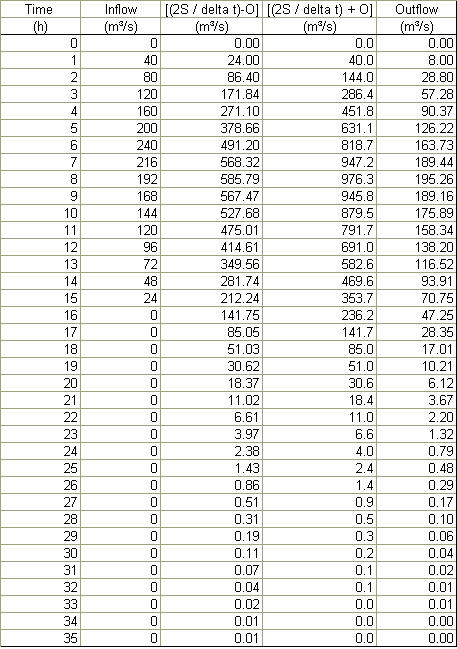SPRING 2010
SOLUTIONS TO HOMEWORK 10, CHAPTER 8
Problem 10-1
With K = 2 h, and Δt = 1 h, the routing coefficients (Eqs. 8-16 to 8-18) are: C0 = 1/5; C1 = 1/5; and C2 = 3/5.
The calculated peak outflow is 195.26 m3/s, and it occurs at 8 h.
The same answer is obtained with ONLINEROUTING01. ANSWER.
Problem 10-2
With K = 2 h: S = 2 • (O). With Δt = 1 h, the storage-indication-outflow relation O = [(2 • S / Δt) + O] is:
O = (1 / 5) [(2 • S / Δt) + O]. The calculations are shown in the following table.
The calculated peak outflow is 195.26 m3/s, and it occurs at 8 h. The same answer is obtained with ONLINEROUTING02. ANSWER.
Problem 10-3
First develop the spillway rating, using Q = CL H3/2 = 1.7 • 20 • H3/2. Then, using ONLINEROUTING03, the peak outflow is:
Qp = 160 m3/s.
The maximum water surface elevation corresponding to this peak outflow is: 122.793 m.
Since the dam crest elevation is at 125 m, the actual freeboard is: FB = 125.0 - 122.793 = 2.207 m. ANSWER.
Problem 10-4
With the given reservoir and design flood conditions, the objective is to determine the emergency spillway length (width)
(rectangular cross section) that produces a maximum water surface elevation of 481.0 m, i.e., the difference
between dam crest elevation (483.0 m) and design freeboard (2.0 m). The calculation proceeds by trial and error, using ONLINEROUTING03.
The final spillway length (width) is 9.0 m.
Using ONLINEROUTING03 with the given reservoir data and design flood conditions, the peak outflow is:
Qp = 225.287 m3/s.
The routing computations are shown in the following table.


The maximum water surface elevation corresponding to this peak outflow is: 481.007 m.
Since the dam crest elevation is at 483 m, the actual freeboard is: FB = 483.0 - 481.007 = 1.993 m. ANSWER.